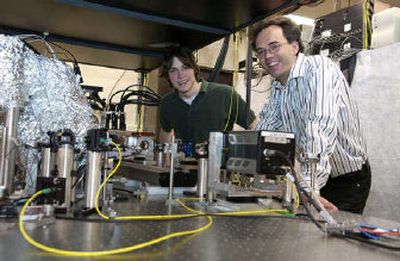Science nears lowest low with physicist’s creation

A physicist at Washington State University has created a very cold, very strange little glob of atoms.
It’s called a Bose-Einstein condensate, and it’s colder than anything in the universe – billions of times chillier than deep space. And what happens to the atoms in that state is among the leading subjects of physics over the past decade, suggesting possibilities for learning more about neutron stars and developing technologies on Earth.
“Bose-Einstein condensates have advanced into the center of modern atomic physics,” said Peter Engels, an assistant professor and researcher at WSU. “In a way, it bridges the gap between the nanocosmos and our classical world.”
Engels’ team spent a year and a half building and fine-tuning the system of lasers and a vacuum to create the substance, and recently became the first lab in the Northwest to achieve it. The existence of the ultra-cold state was predicted by Albert Einstein in the 1920s, but wasn’t produced until 1995, by scientists at the University of Colorado and MIT. They won the Nobel Prize in 2001 for their work.
Reproducing a Bose-Einstein condensate remains very difficult. It takes a complicated series of steps involving laser cooling, vacuum chambers and a magnetic field, and the condensate itself is among the most fragile states on Earth.
It’s also a place where quantum weirdness is on display. Quantum physics – or the science of the very small – exhibits properties that make no sense to our view of the classical, visible world. For example, in quantum mechanics, the precise location and speed of fundamental particles can’t be known exactly, but only predicted. And physicists believe that’s not because our knowledge is limited, but because at the fundamental level, the world is governed by uncertainty.
Another quantum effect is the wave-particle duality – matter sometimes acts as a particle, and sometimes like a wave. In a Bose-Einstein condensate, the wave nature of matter becomes apparent, as atoms become blurred or linked together into one dense entity sometimes called a “superatom.”
“One of the most startling effects is that atoms start behaving like waves rather than classical particles,” Engels said.
Composed of gaseous atoms that are cooled to almost absolute zero – 459 degrees Fahrenheit below zero – the condensates are still in the early stages of research and possible uses remain speculative. But they suggest a wide range of possibilities for experiments in nuclear physics; astrophysics; and quantum optics, the way matter interacts with light, WSU said.
A Harvard scientist has used Bose-Einstein condensates to slow down the speed of light, a process that may help lead to the creation of superfast computers that use light instead of electrons to process information. Engels said the substance may also be useful for scientists trying to learn more about extreme states of matter, such as the superhot cores of neutron stars.
The condensates were named for physicists Satyendra Nath Bose and Einstein, who in the 1920s theorized that gases would condense into the unusual form if temperatures that low could ever be attained.
The process of creating a condensate involves ribidium atoms that are placed in a vacuum and hit with six laser beams. The lasers essentially trap some atoms, and the gradual bombardment of photons slows them down, making them slower and colder until they’re a millionth of a degree Fahrenheit above absolute zero. An evaporative process makes the substance even colder – to a billionth of a degree of absolute zero.
The resulting substance exists only for a minute or two, but that’s long enough to perform experiments and begin learning more, he said.
It took a lot of time and effort to make it happen, and Engels’ team finally created the substance on May 4. A colleague marked the occasion with champagne.
“That was quite a day,” he said.